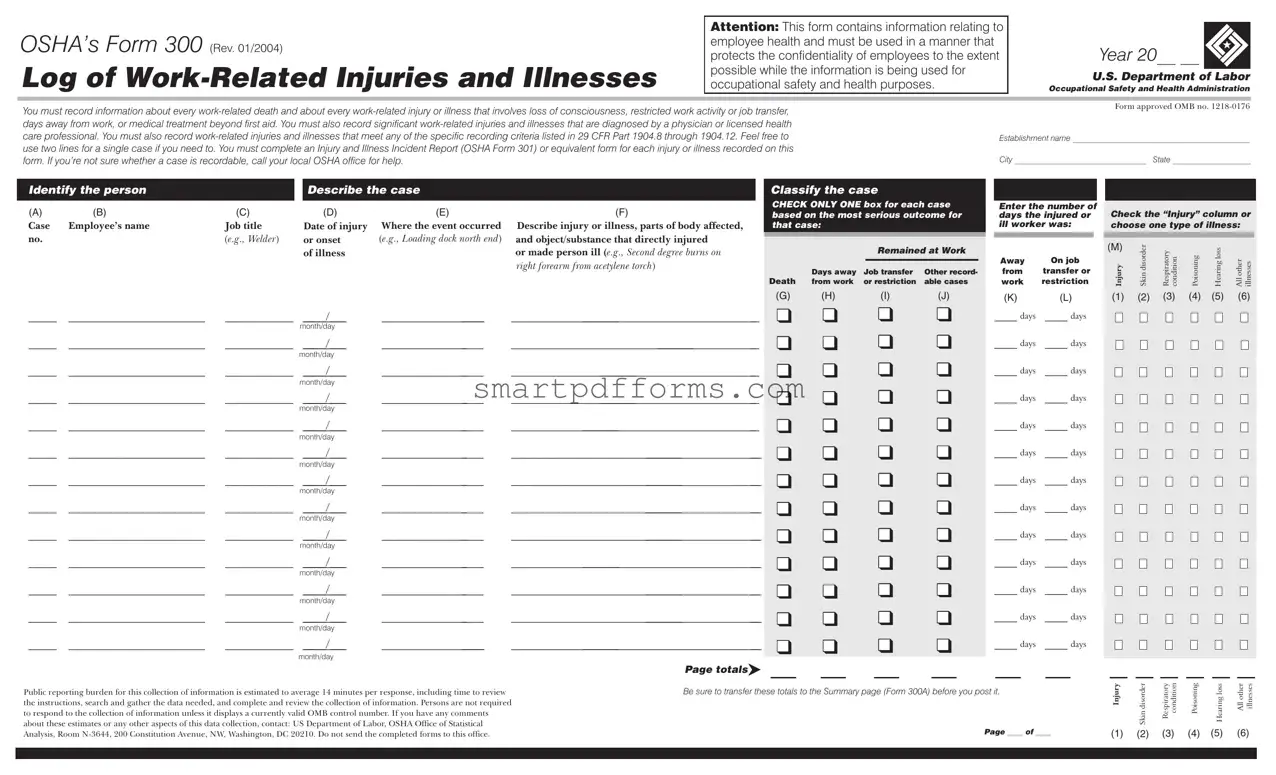This Injury and Illness Incident Report is one of the first forms you must fill out when a recordable work- related injury or illness has occurred. Together with the Log of Work-Related Injuries and Illnesses and the accompanying Summary, these forms help the employer and OSHA develop a picture of the extent and severity of work-related incidents.
Within 7 calendar days after you receive information that a recordable work-related injury or illness has occurred, you must fill out this form or an equivalent. Some state workers’ compensation, insurance, or other reports may be acceptable substitutes. To be considered an equivalent form, any substitute must contain all the information asked for on this form.
According to Public Law 91-596 and 29 CFR 1904, OSHA’s recordkeeping rule, you must keep this form on file for 5 years following the year to which it pertains.
If you need additional copies of this form, you may photocopy and use as many as you need.
Completed by _______________________________________________________
Title _________________________________________________________________
Phone (________)_________--_____________ |
Date _____/ _____ / _____ |
Information about the employee
1)Full name _____________________________________________________________
2)Street ________________________________________________________________
City ______________________________________ State _________ ZIP ___________
3)Date of birth ______ / _____ / ______
4)Date hired ______ / _____ / ______
5) Male
Female
Information about the physician or other health care professional
6) Name of physician or other health care professional __________________________
________________________________________________________________________
7)If treatment was given away from the worksite, where was it given?
Facility _________________________________________________________________
Street _______________________________________________________________
City ______________________________________ State _________ ZIP ___________
8)Was employee treated in an emergency room?
Yes
No
9)Was employee hospitalized overnight as an in-patient?
Yes
No
Information about the case
10)Case number from the Log _____________________ (Transfer the case number from the Log after you record the case.)
11) |
Date of injury or illness |
______ / _____ / ______ |
|
12) |
Time employee began work ____________________ |
AM / PM |
13) |
Time of event |
____________________ |
AM / PM Check if time cannot be determined |
14)What was the employee doing just before the incident occurred? Describe the activity, as well as the tools, equipment, or material the employee was using. Be specific. Examples: “climbing a ladder while carrying roofing materials”; “spraying chlorine from hand sprayer”; “daily computer key-entry.”
15)What happened? Tell us how the injury occurred. Examples: “When ladder slipped on wet floor, worker fell 20 feet”; “Worker was sprayed with chlorine when gasket broke during replacement”; “Worker developed soreness in wrist over time.”
16)What was the injury or illness? Tell us the part of the body that was affected and how it was affected; be more specific than “hurt,” “pain,” or sore.” Examples: “strained back”; “chemical burn, hand”; “carpal tunnel syndrome.”
17)What object or substance directly harmed the employee? Examples: “concrete floor”; “chlorine”; “radial arm saw.” If this question does not apply to the incident, leave it blank.
18) If the employee died, when did death occur? Date of death ______ / _____ / ______
Public reporting burden for this collection of information is estimated to average 22 minutes per response, including time for reviewing instructions, searching existing data sources, gathering and maintaining the data needed, and completing and reviewing the collection of information. Persons are not required to respond to the collection of information unless it displays a current valid OMB control number. If you have any comments about this estimate or any other aspects of this data collection, including suggestions for reducing this burden, contact: US Department of Labor, OSHA Office of Statistical Analysis, Room N-3644, 200 Constitution Avenue, NW, Washington, DC 20210. Do not send the completed forms to this office.





